We had a regular meeting at the Rivet with a live sharpening demonstration planned. Unfortunately Larry suffered an accident prior to the meeting so we watched a sharpening video instead.
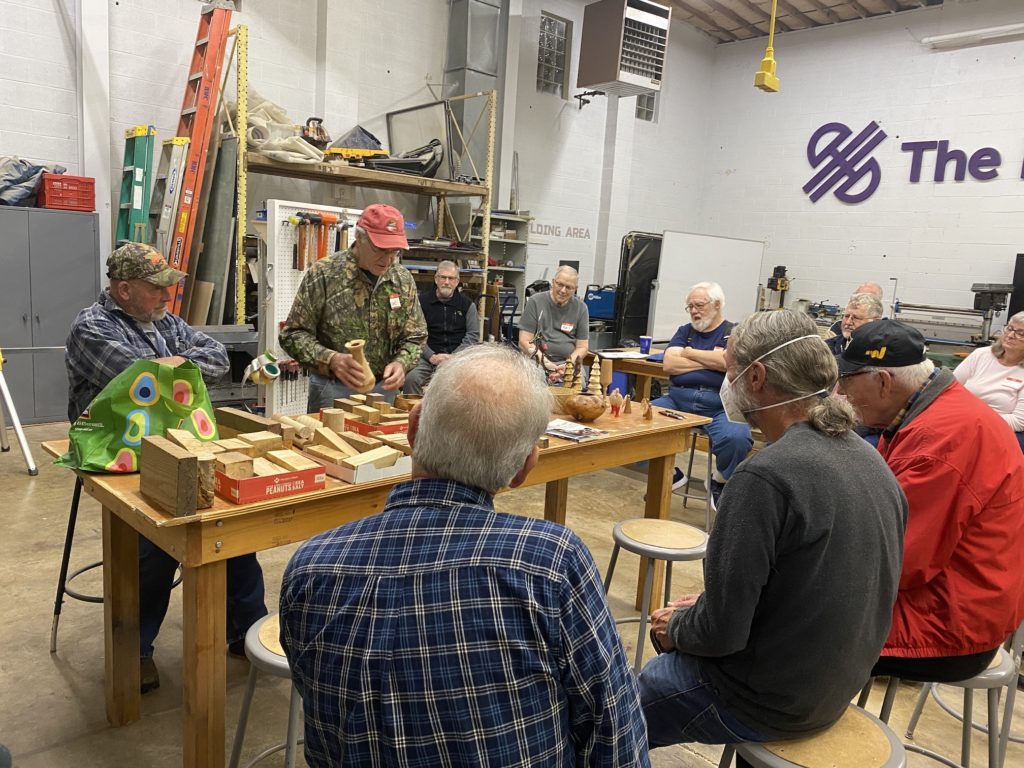
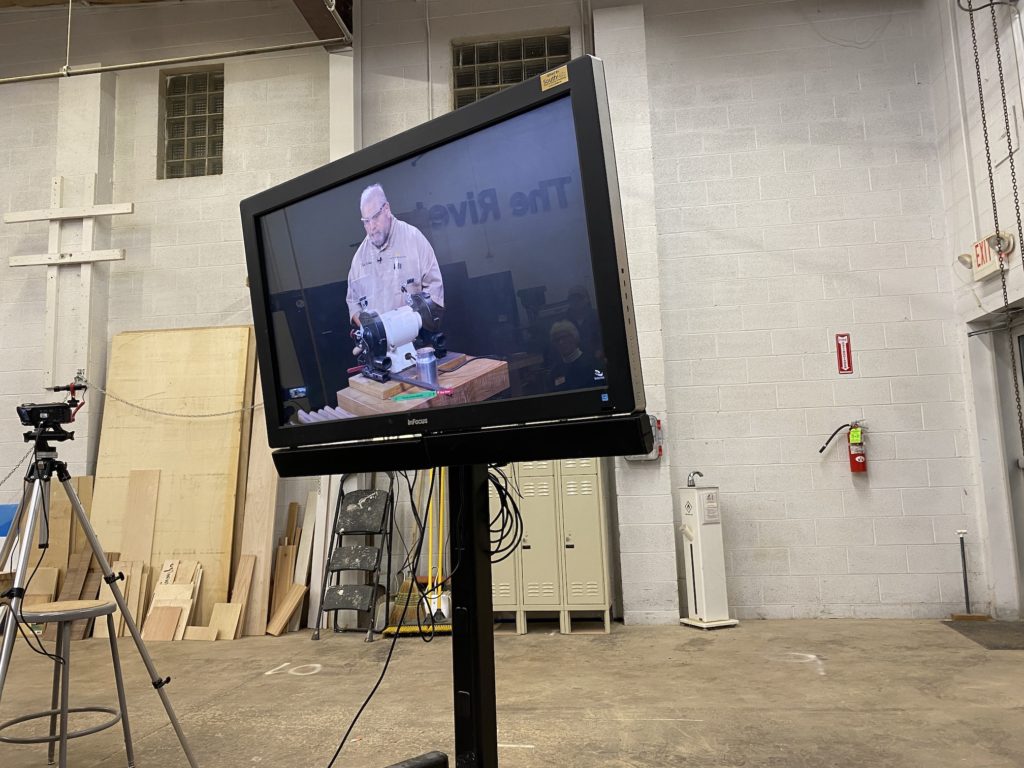
We had a regular meeting at the Rivet with a live sharpening demonstration planned. Unfortunately Larry suffered an accident prior to the meeting so we watched a sharpening video instead.


Paul Demmert showed how 8 different finishes look on bowls made from the same wood and ranked and rated them on various attributes. His notes are below the meeting video.
The genesis of this presentation was a presentation the club had several years ago with Jim Finley talking about finishes. The idea that took root in my mind was to show a variety of finishes on bowls that were all the same kind of wood. This would allow a comparison among the different finishes.
About 1 year ago I got access to a large log of American Holly and that was an opportunity to build this presentation on the different finishes. American Holly, Ilex opaca, is a species of holly, native to the eastern and south-central United States, from coastal Massachusetts south to central Florida, and west to southeastern Missouri and eastern Texas. It is the state tree of Delaware. Ilex opaca is a medium-sized broadleaved evergreen tree growing on average to 10–20 m (33–66 ft) wide canopy, and up to 30 m (98 ft) tall. Typically, its trunk diameter reaches 50 cm (20 in), sometimes up to 120 cm (47 in). The bark is light gray, roughened by small warty lumps. The wood is very pale, tough, close-grained, takes a good polish, and is used for whip-handles, engraving blocks and also cabinet work. (specialty items such as fancy cabinet inlays, small pieces of furniture, brush backs, handles, novelties, wood engravings, scroll work, woodcuts and carvings, and measuring scales and rules for scientific instruments). Ideal lumber has a very uniform, pale white color with virtually no visible grain pattern. Janka Hardness: 1,020 lbf (red oak 1290, black walnut 1010, cherry 950)
Because Holly has such a subdued grain pattern, it takes coloring dyes very well. Because of this, Holly can be dyed black and used as a substitute for ebony–for piano keys, violin pegs, and fingerboards. Knots are common, which can reduce the usable area of the wood.
Holly is usually cut during the winter and kiln dried shortly thereafter to preserve the white color of the wood. Holly can develop a bluish/gray fungal stain if not dried rapidly after cutting and this will be evident on the bowls I have for this presentation, because I didn’t get the bowls turned until over 6 months after it had been cut down in the late summer to early fall.
I have turned holly once before and that was a tree that had been cut down at my Father-in-Laws house and my wife grabbed a couple of sections of that tree after it had been hauled off to the dump. I turned that holly green, right after Leslie got it home so the resultant bowls were pure white, with no visible grain, almost like porcelain. Again this holly was turned within a month of being cut down.
This wood came from a landscape company in Altoona. In the fall of 2021 I went to pick up the wood. It was a single log, 8 ft long, 12-14 in diameter. The worker helped me by cutting the log into sections that were 16-18 in long, weighing about as much as a single person could carry. I stored the sections in my basement and painted Anchor Seal on the ends of the sections to seal the end grain.
Later I cut the sections in half with my chainsaw, right down the pith, giving me 2 bowl blanks per section.
I turned all of the bowls from March 6 to April 9 2022. All of the bowls were turned green, with the foot of the bowls pointing to the bark part of the blank, the inside of the bowls oriented towards the pith or the center of the tree. These bowls were only turned once, air dried for about 5 months (from April to August), and hand-sanded. Note that my bowls are functional, rather than artistic—wall thickness is between 3/16 to 3/8 inch. There was some movement in the bowls during drying, but some bowls help their shape pretty well. None of the bowls were remounted for a second turning. I started finishing the bowls in late August and applied last coat in early October.
Finishes Used
#1 Shellac (1# cut) dewaxed super blonde flakes dissolved in denatured alcohol
#2 Total Boat Varnish Clear Gloss
#3 Minwax Polycrylic Clear Satin
#4 Minwax Spar Urethane Clear Gloss
#5 Behlen Mohawk Salad Bowl Finish Clear
#6 Watco Danish Oil
#7 Deft Brushing Lacquer
#8 Waterlox Original Tung Oil
Procedure
220 grit First coat
320 grit Second coat
400 grit Third coat
600 grit Fourth coat
Total coats of finish: 6 or more
Buffed with white pad = 0000 steel wool to knock off dust nibs
Results
Various differences between the finishes include how does it flow (drips, brush marks, drying time), the general appearance of the finish, the cost, and cleanup.
Flow
Finishes that flow nicely: shellac, Minwax Spar Urethane, Behlen Mohawk Salad Bowl, Watco Danish Oil, Deft Brushing Lacquer, Waterlox
Others: Total Boat Varnish and Minwax Polycrylic tended to be thick and left drips (better when thinned with water)
Deft Brushing Lacquer has levelling agents that almost eliminate brush marks.
Shellac, Total Boat Varnish, and Deft Lacquer dry very fast.
Watco Danish Oil very slow drying and stays tacky
General Appearance of the Finish
In this demonstration, I did not try to sand and buff out the bowls to make them perfect. Some of them still have brush marks and other defects in the finish that I need to address. I wanted to concentrate on the impression the finish makes on the viewer. This is very subjective. Also remember that results are dependent on the wood species—particularly if you are looking to see how much the tone of the wood has darkened after finish has been applied. This would not be a consideration if the bowls were turned from walnut, cherry, hickory, or other darker woods.
From my perspective #4, #3, #7 and #2 take on the “best” appearance, because these bowls still retain a lighter tone that is more consistent with the lighter color of Holly.
Bowls #6 and #8 come in at the end of the pack for the same reason—they darken the tone of the wood too much. Even though, #8 has a nice looking finish overall.
Cost
Most of the cost figures used in my analysis come from the prices I paid, either through Amazon or at local stores like Ace Hardware, Lowes, and Home Depot. If you took the time to shop around, you probably could beat the prices I paid.
#1 Minwax Spar Urethane Clear Gloss ($18.86/qt)
#2 Shellac (1# cut) dewaxed super blonde flakes dissolved in denatured alcohol (Flakes $2.20/oz, DNA $4.00/8 oz,= $24.80/qt Zinsser $26.53/qt)
#3 Watco Danish Oil ($24.99/qt)
#4 Deft Brushing Lacquer ($26.13/qt)
#5 Waterlox Original Tung Oil ($32.83/qt)
#6 Behlen Mohawk Salad Bowl Finish Clear ($40.45/qt)
#7 Total Boat Varnish Clear Gloss ($44.00/qt)
8 Minwax Polycrylic Clear Satin ($55.60/qt)
Cleanup
Water soluble: Total Boat Varnish, Minwax Polycrylic
Mineral Spirits: Behlen Mohawk Salad Bowl, Minwax Spar Urethane, Waterlox, Watco
Lacquer Thinner: Deft
Denatured Alcohol: Shellac
Our first meeting after the summer break was a nice relaxed time to catch up on what everyone had been doing and making over the summer with a big show and tell and Q&A time. Held at the normal place, at the normal time – The RIvet at 7pm on the first Wednesday of the month.
This meeting was a Saturday Shop Tour, June 4th, where we went to five member shops to see how each were set up and what goodies they used to make their creations. It was a great time to hang out and learn from each other.
Our hybrid meeting held at the Rivet included a demonstration titled “From Log To Bowl’ by Stephen Tuttle. We learned how Stephen makes decisions on everything from chainsaw safety to mounting the lumber, to rounding a bowl blank, to basic sharpening. Great tips, reminders and examples for everyone.
The demonstration for this meeting was be provided by Ken Vasko. It was a really good follow-up to the presentation at the December meeting about Easy Wood Tools.
Ken covered:

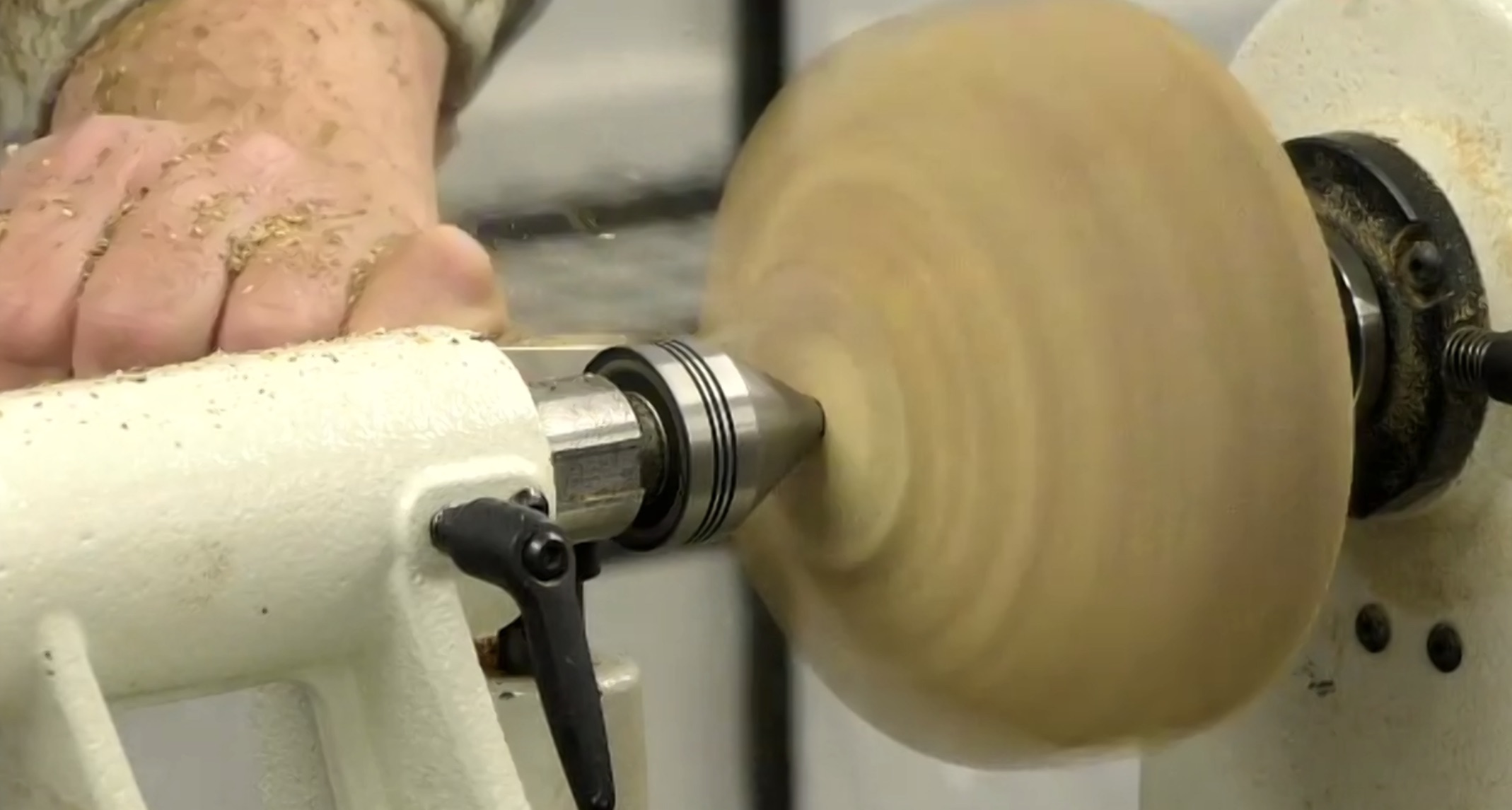
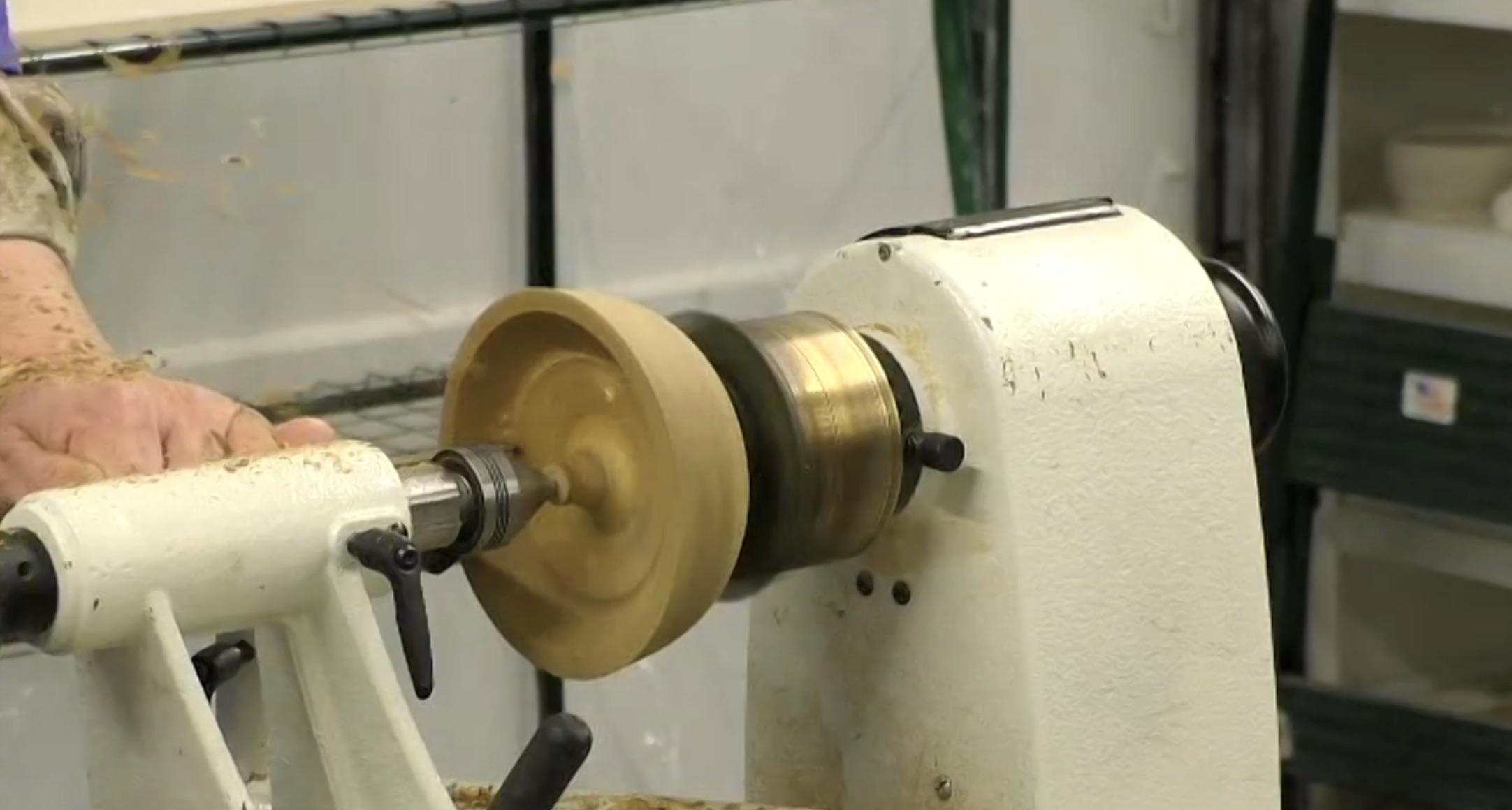
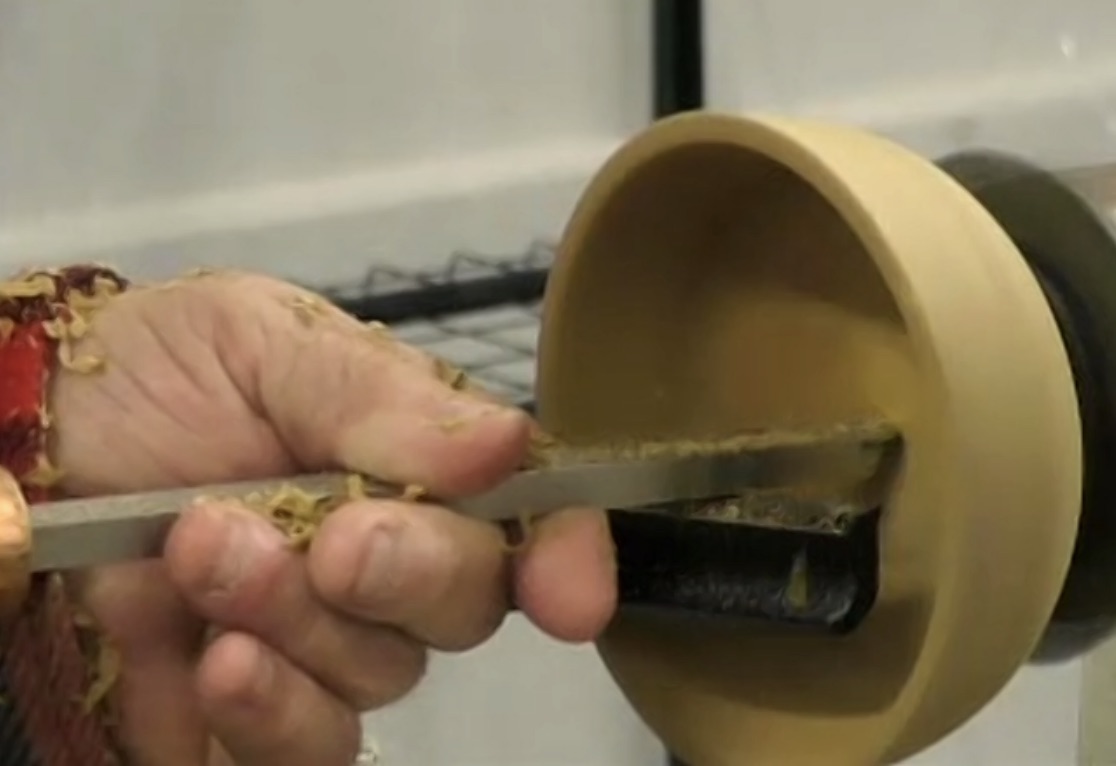
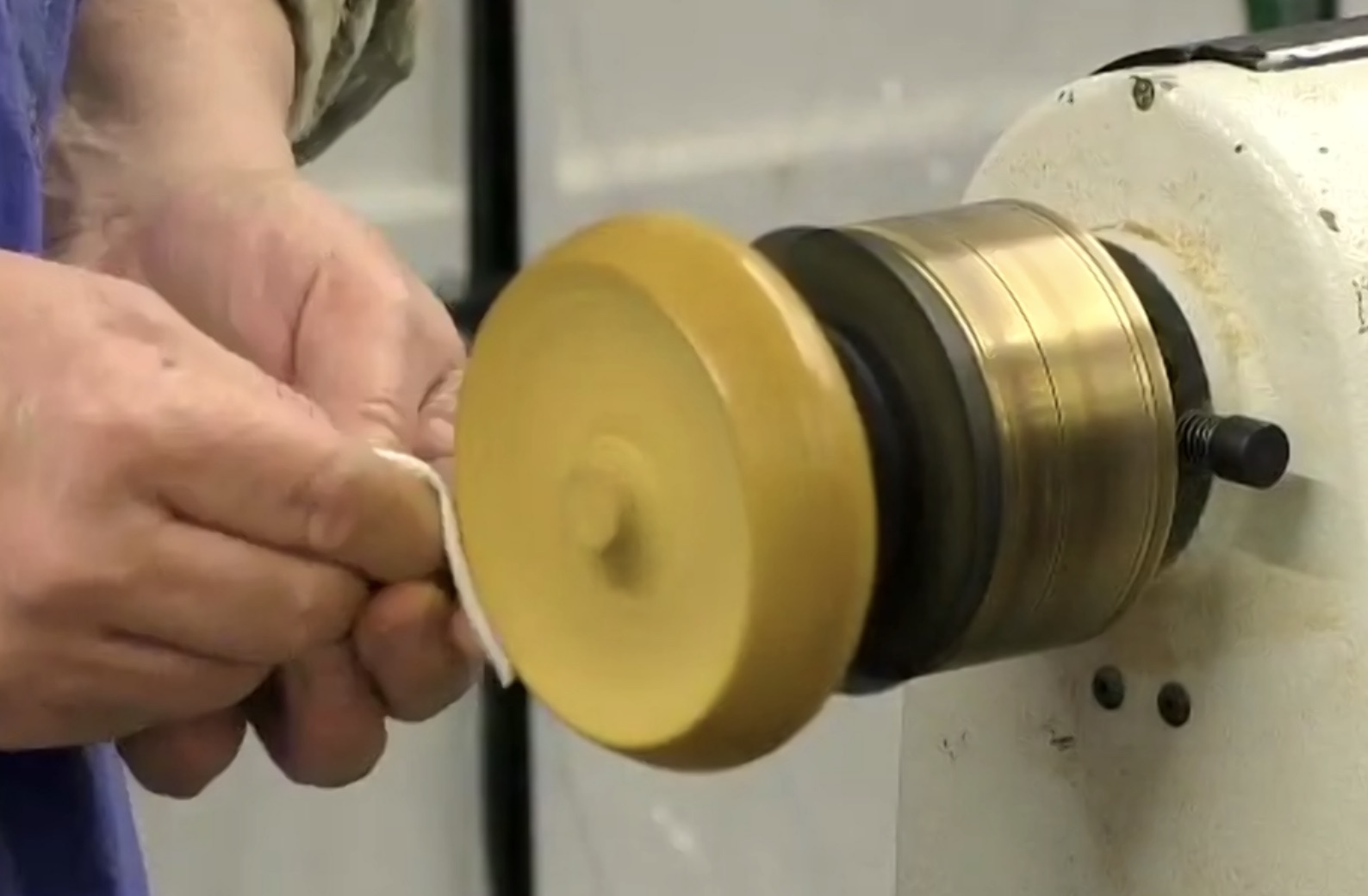
Our previously scheduled presenter had to cancel for personal reasons this month so our pivot was to watch a video about befriending the skew by Alan Lacer. If you have any reservations about using the skew, join us as we watch Alan break it down, show how to sharpen it, use it for 8 different cuts and discover why it can grab and how to avoid catches.
Dave Betler demonstrated his technique for making Stump Boxes. A turned box that he then carves and wood burns to create a realistic looking stump. We had a hybrid meeting using some equipment from the Rivet. Unfortunately the audio never really worked well enough for people watching at home which you’ll notice if you watch the video. Hopefully you can see how Dave does it despite the lack of audio.
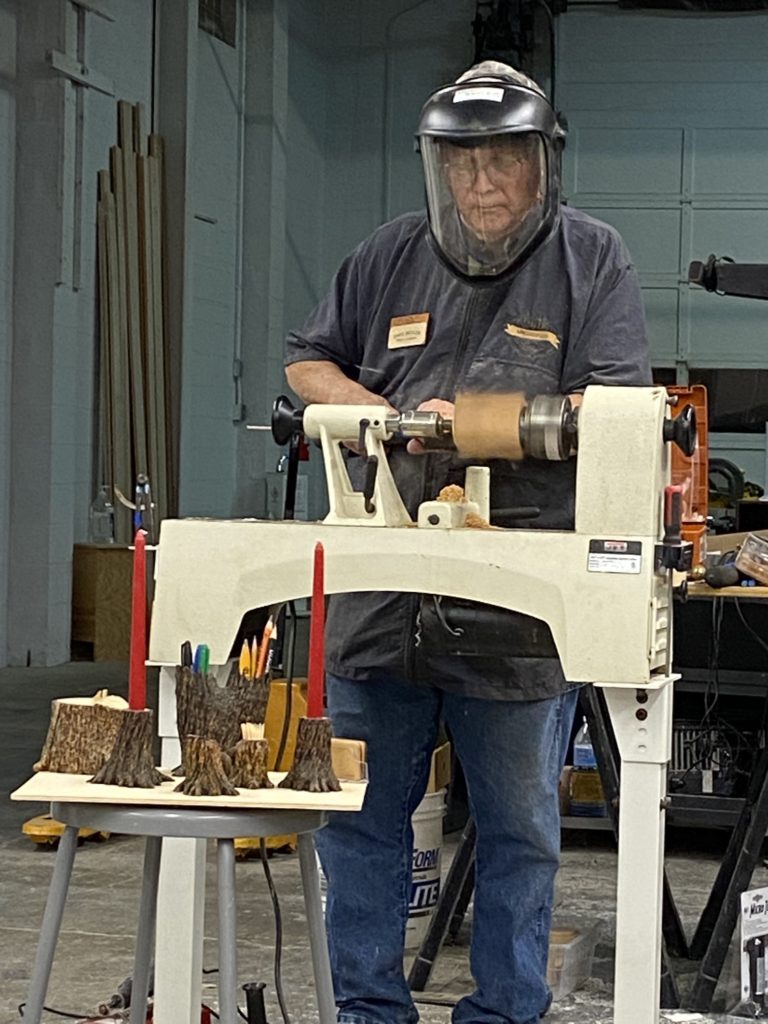
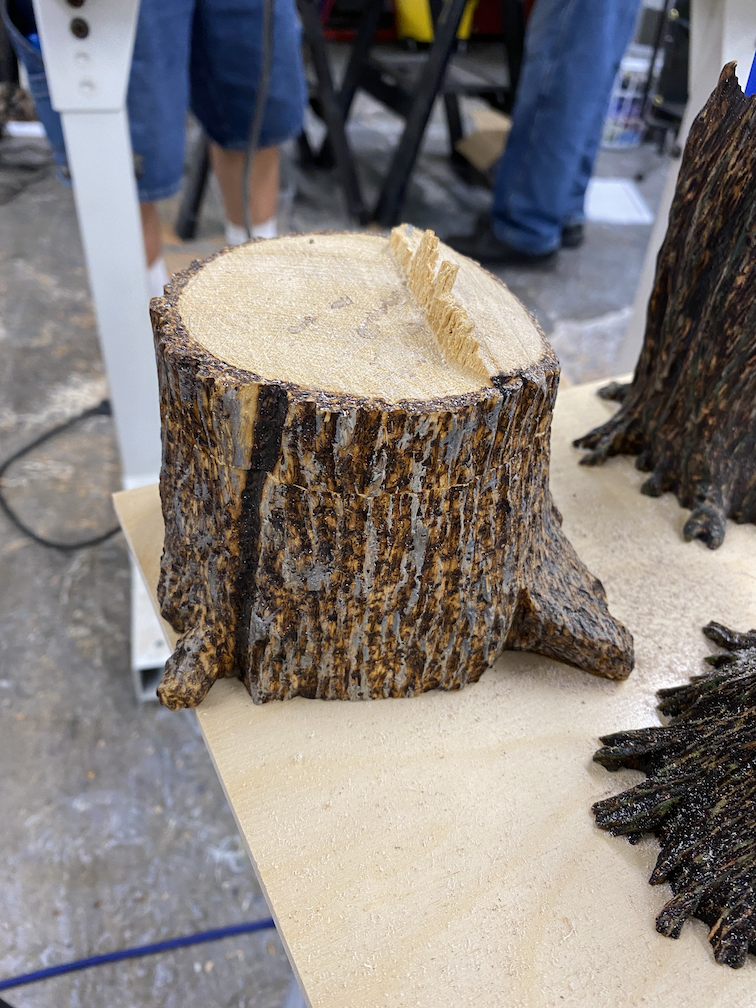
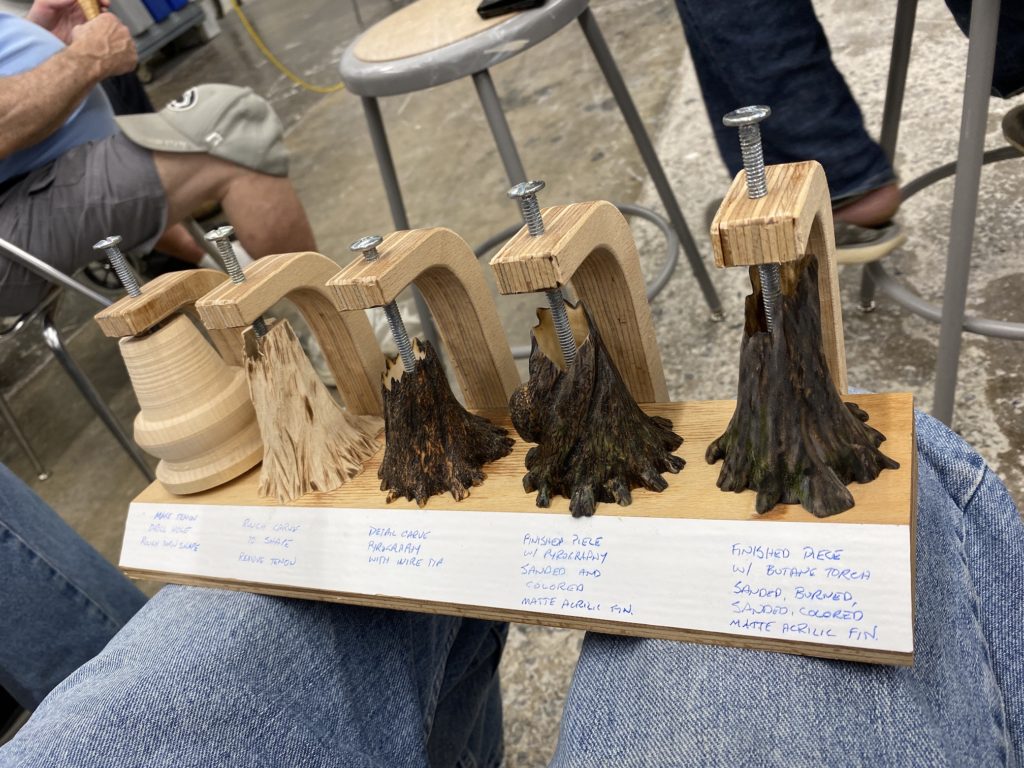

We had an informative meeting this month all about segmented turning, thanks to a detailed slide show presentation with several samples on disply by Tony Omeis. We met at the Rivet with several others joining over Zoom. We expect more hybrid meetings like this in the future to allow for the most participation as possible. Thanks to all who joined us.
Our “try it challenge” for this month is to make your own segmented object. Give it a try and show us what you made at the next meeting in the fall. Enjoy the summer and make some shavings.
Show and tell examples:
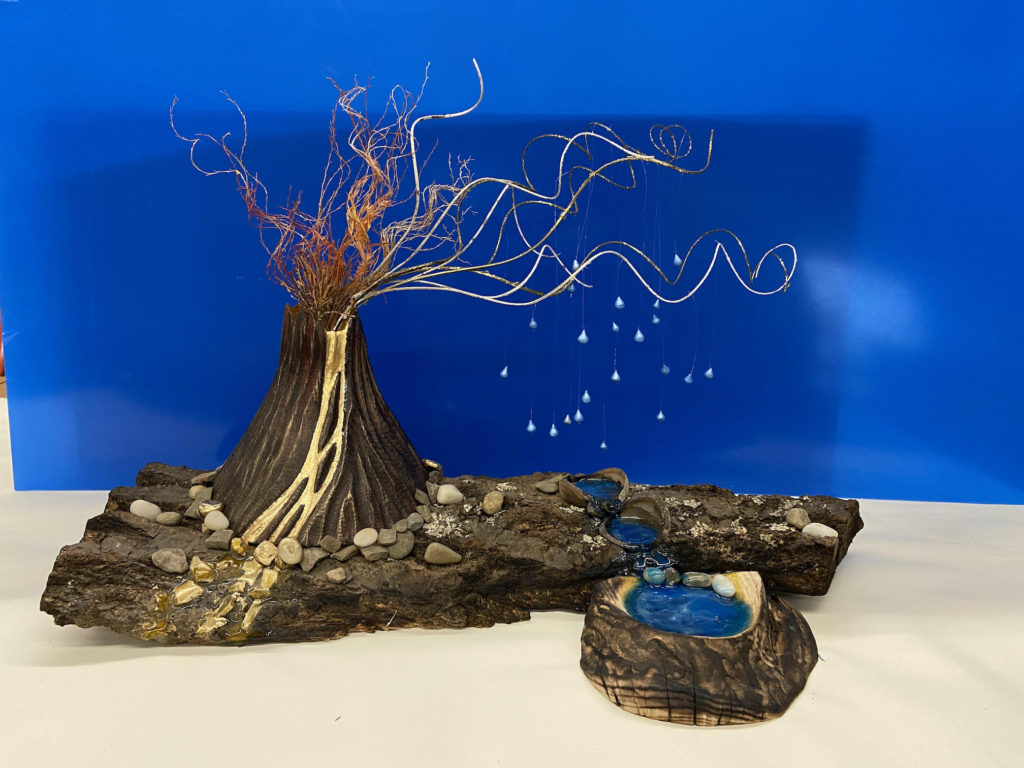
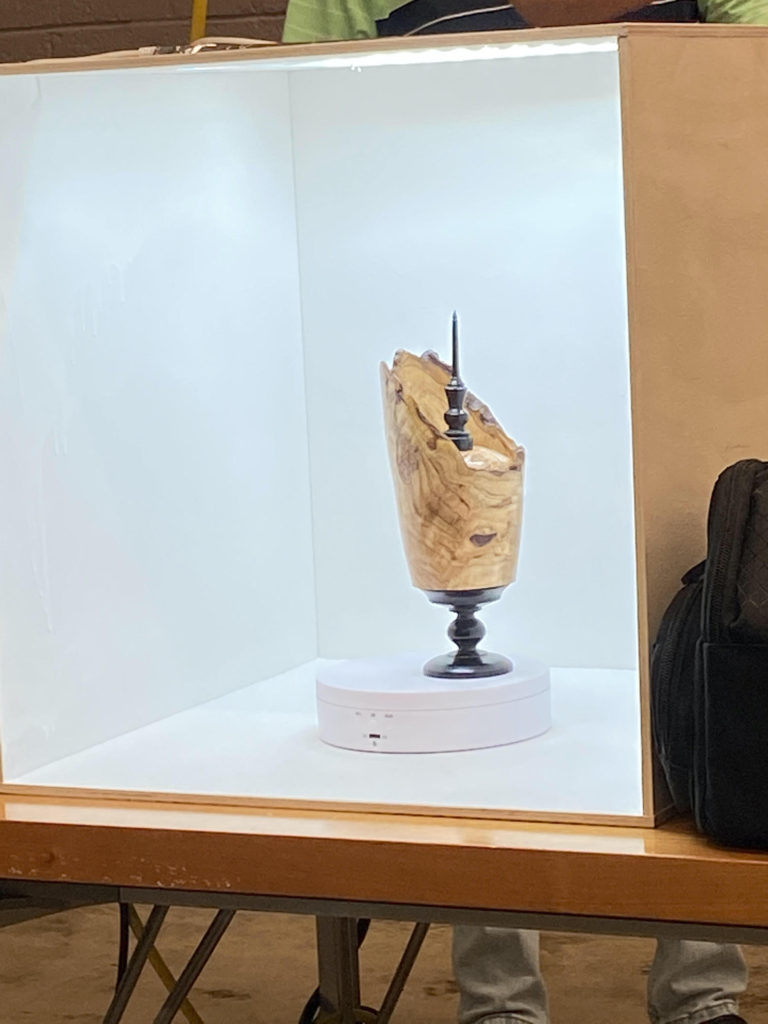
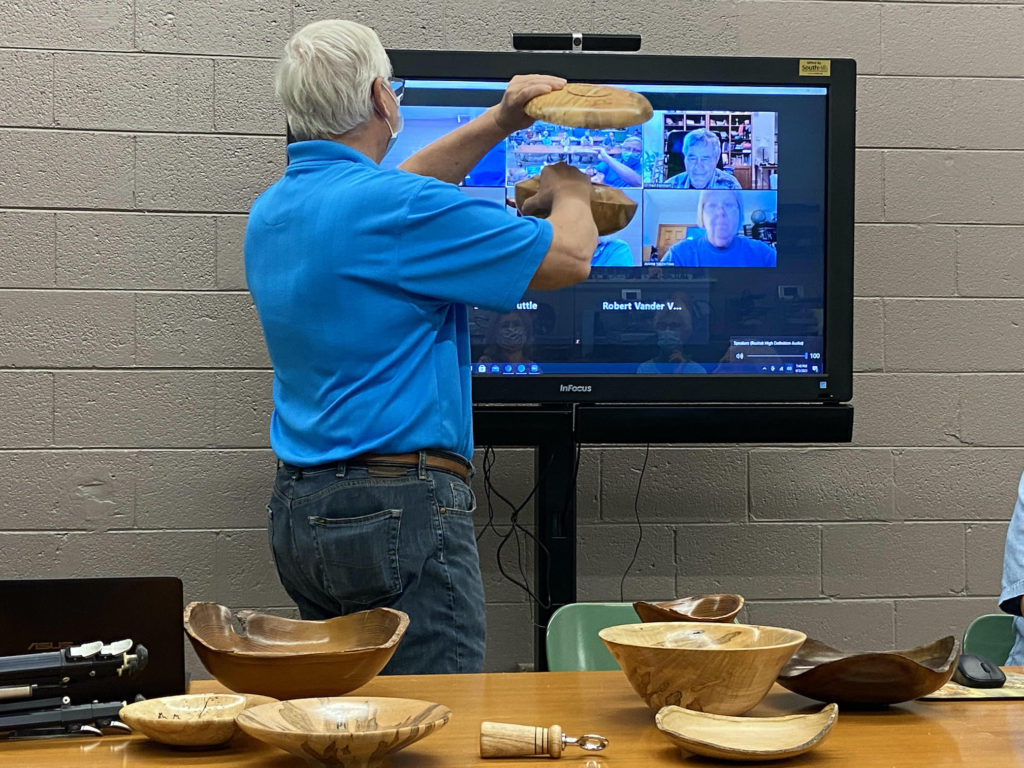
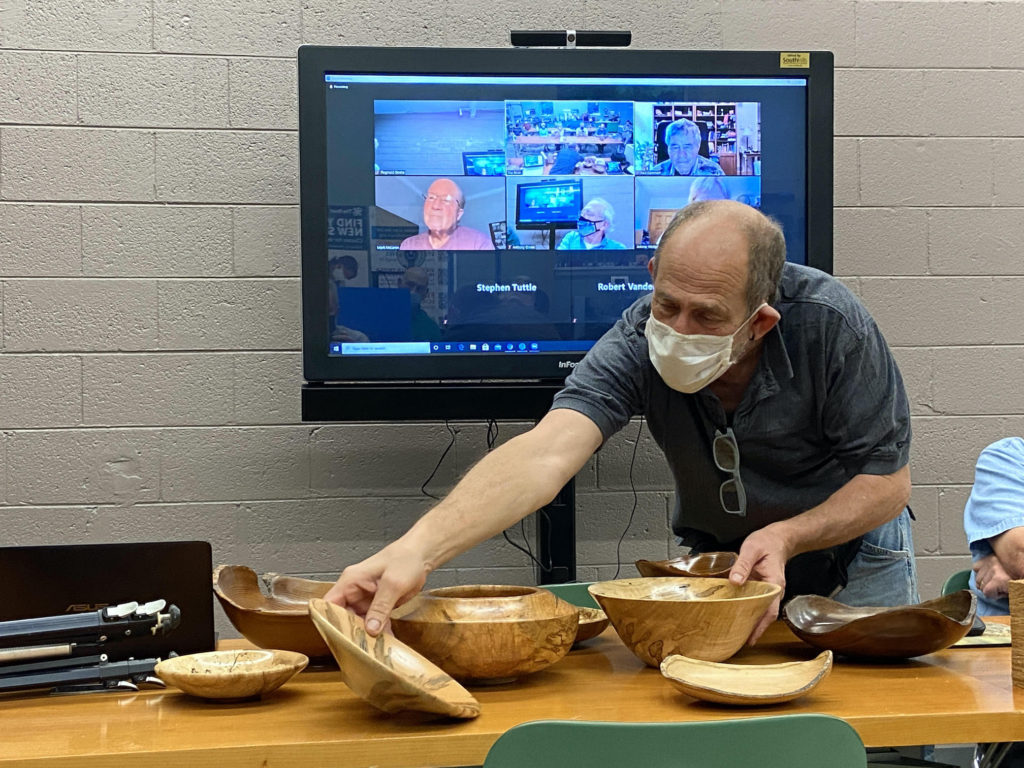
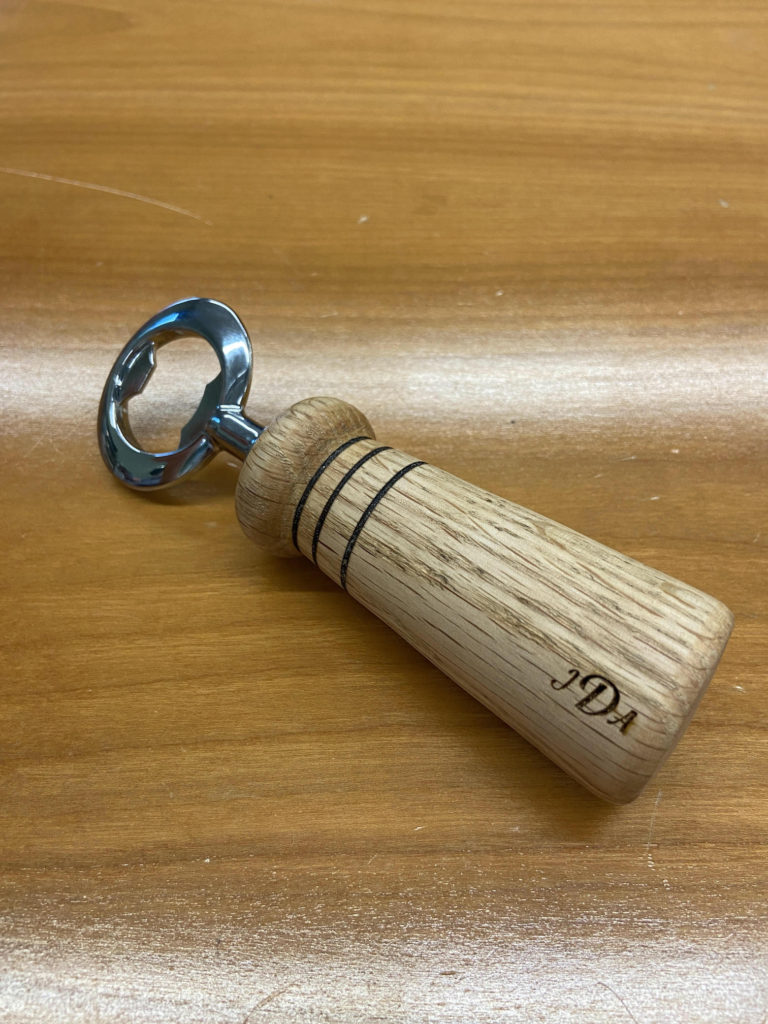
We had another GREAT demo from a member’s shop, thanks to an outstanding presentation by Mike Lebo of how to make a thin necked goblet. Good attendance, great conversation and Q&A, made for a successful meeting during the pandemic. Thanks all who participated.
Our “try it challenge” for this month is to make your own thin necked goblet. Give it a try and show us what you made at the May meeting and you’ll get a chance to win something in our quarterly drawing.